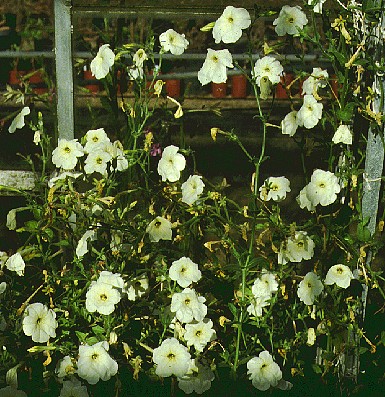
Synonymy
*Petunia axillaris (Lam.) Britton, Sterns & Pogg., Prelim. Cat. 38 (1888)
Nicotiana axillaris Lam., Tabl. Encycl. 2: 7 (1794).
T: Described from Montevideo, Uruguay, Commerson s.n.; iso: ?P n.v.
Nicotiana obtusisepala Domin, Biblioth. Bot. 89: 593; t. 36, fig. 1 (1929), fide D.E.Symon, J. Adelaide Bot. Gard. 3: 147 (1981).
T: Hughenden, Qld, Feb. 1910, Domin s.n.; holo: PR n.v., photo ADW.
Description
Annual or short-lived perennial herb. Stems erect or decumbent.
Leaves ovate to elliptic, the lamina 2–7 cm long; lower leaves alternate, petiolate; upper leaves sometimes opposite, sessile or almost so, decreasing in size on flowering stems.
Pedicels 2–4 cm long. Calyx 10–20 mm long; lobes oblong. Corolla white; tube obconical, 30–45 mm long; limb rotate to broadly stellate, 40–60 mm diam.; lobes rounded. Stamens on filaments 10–15 mm long; anthers 2–3 mm long. Style 20–30 mm long, erect.
Capsule conical, obtuse, 8–12 mm long, not or shortly exceeded by calyx-lobes. Seeds globular or sub-angular, 0.6 mm diam., light brown.
Distribution and ecology
Occasionally grown as an ornamental, but naturalised in waste ground in south-eastern Qld, eastern N.S.W. and Mt Lofty Ranges in S.A. The AVH map also shows an occurrence in Western Australia in the Perth region, but the species is not recorded in the census of Western Australian plants.
Common name
Large white petunia (US)
Notes
Sometimes grown as an ornamental.
The garden petunia, P. hybrida, is a result of crosses between this species and P. integrifolia. Whether the material encountered here is from an introduction of the species or reversions from the garden petunia is not known.
Distinguishable from P. hybrida by its much narrower throat width and often by the insertion of the stamens midway in the corolla tube rather than at the base.
"Petunia axillaris has white flowers with long and narrow corolla tubes, emits large amounts of volatiles at night, and contains large volumes of floral nectar. Pollination is primarily by nocturnal hawk moths."
Reference: M.E. Hoballah,
Selected specimens
Qld: Helidon, P.R. Sharpe & B.L. Lebler 2476 (BRI); 3 km from Texas on Inglewood road, P.I.Forster 19820 (AD, BRI, MEL, NSW). N.S.W.: 30 km SE of Bonshaw, S. Jacobs 3377 (NSW). S.A.: Between Wychwood and the Harwood bushland trail (Mt Lofty), R.Bates 40886 (AD).
Derivation of epithet
From axillaris, Latin for from the axils, a reference to where the flowers arise.
Images and information on web
The CalPhotos site has an image of P. axillaris and further information about it can be obtained from the Plants Profile page of the US Department of Agriculture.
There is a close-up of the flower of what is reputed to be this species at www.anniesannuals.com/plants/plant_display.asp?prodid=3124 with reference to the fragrance of the flowers and also an image showing a hawkmoth visiting them (see Notes above for a reference to pollination).


